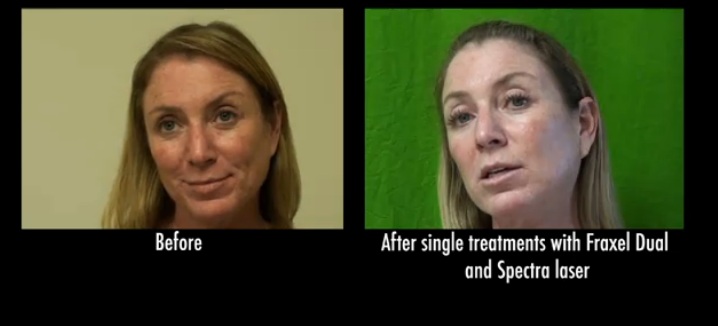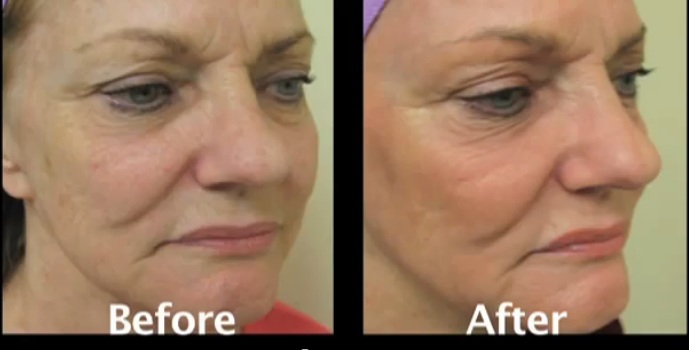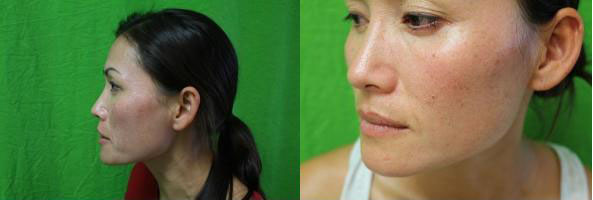Age spots are also known as brown spots, sun spots or solar lentigines . They are flat and often brown, but can also be black or gray as well. These pigmented spots can range in size. They can appear on any region of the skin that is exposed to the sun:
- Face
- Hands
- Arms
- Shoulders
Although age spots are harmless, many people want to remove them for a more even looking complexion.
What Causes Age Spots?
It was formerly thought that these areas of pigmentation were due to liver issues. However, they are caused by sun damage.
The color of our skin is due to a pigment called melanin. However prolonged and excessive sun exposure will cause melanin to be released in spurts. These secretions are the cause of age spots. Melanin is a pigment which helps to protect the skin from damaging sun rays. Therefore, it almost like a natural form of sunscreen that our bodies produce. As our skin ages, it becomes less able to recover from UV rays. So melanin is secreted to help offer additional protection.
Treating Age Spots Safely and Effectively
The melanin of the age spots lie beneath the skin’s surface. This is why topical treatments can be slow and ineffective.
Hydroquinone
Hydroquinone is a commonly used topical cream which helps fade brown pigmentation on the skin. Over the counter, it is often available in a 2% strength. But stronger concentrations like 4% would need to be prescribed. Hydroquinone works by blocking an enzyme known as tyronsinase which is involved in melanin production. The cells that contain the pigment (melanocytes) carry organelles known as melanosomes which break down as a result of hydroquinone. This is a very slow process. Due to it toxic risks, the FDA has enabled a 3 month limit on the continuous use of hydroquinone.
However, laser light energy can reach areas below the surface to break up the pigment. The remains are then cleared away by the body. At Fine Touch Dermatology, we offer advanced forms of treatments for age spots such as:
- Fraxel Dual
- Fraxel Repair
- Spectra laser
Fraxel Dual
This laser includes two wavelength modes: 1927nm and 1550nm. 1927 can help clear pigmentation in the surface layers of the skin. 1550 is longer and can reach deeper layers.
Fraxel Dual is safe for all ethicities
Fraxel Repair
Fraxel Repair can also be used to clear away brown spots. However, it is only recommended for patients with very light skin tones.
Spectra Laser
Spectra is an Nd:YAG laser which performs with the 1064nm wavelength which is safe for individuals of all skin tones. It can also be applied towards various forms of pigmented lesions which are more difficult to address with other lasers.
This laser is also used to remove tattoo pigment. With age spots, it is an ideal choice for treating a small area.
Common Questions About Age Spot Removal
(1) What areas can be treated with laser for removing age spots?
Lasers can safely remove age spots from any region that receives sun exposure such as the neck, chest, arms, shoulders and face
(2) After a procedure, will more age spots appear?
The same age spots will not come back. But new ones can surely develop. However, this can be prevented by wearing protective clothing and sunscreen.
(3) How many treatments will I need?
Usually only one or two sessions are sufficient. But in more severe cases when the pigmentation covers a larger area, additional treatments may be needed.
(4) What types of procedures should a person with ethnic skin look for in getting rid of age spots?
Individuals with darker skin tones can undergo laser procedures that use longer wavelengths. Again, this includes 1550nm, 1927nm and 1060nm. This energy does not scatter as much as shorter wavelengths.
Therefore, these forms of laser energy are not likely to be absorbed by surrounding areas of melanin. There is less risk of overheating.
Preventing Age Spots
The leading cause of age spots is sun exposure. Therefore avoiding and shielding the skin from excessive UV rays is the best way to prevent the formation of age spots. Helpful measures include:
- The use of sunscreen (SPF 30 or higher)
- Avoiding intense exposure to the sun. This means being aware of peak hours, such as mid day and early afternoon. Wearing protective clothing and sun glasses will also be helpful as well.
- Applying window film to the car which blocks UVA rays which result in age spots.
Patient Photos
This patient wanted to get rid of brown spots on her face for a more even complexion. She received excellent results with just one treatment.
This Redondo Beach patient was able to get rid of age spots with the use of Fraxel Dual. She also received treatment with the Spectra laser to improve her skin’s texture.

Los Angeles patient who underwent treatments with Spectra and Fraxel Dual which helped improve the appearance of age spots.*
This patient received Fraxel Repair to clear away age spot pigmentation.

Redondo Beach patient who received a Fraxel Repair treatment to improve the appearance of age spots*
Related Condition – Poikiloderma
Poikiloderma is also a skin condition involving unwanted pigmentation, usually on the cheeks, chest and neck. It is characterized by coloration changes. Typically, this includes mottled brown and red spots. However, it may also involve hypopigmentation (lighter areas) as well as thinning skin and telangiectasia (thin veins). Furthermore, affected individuals may experience sensations of burning, itching or pain.
Types of Poikiloderma
The three main types of Poikiloderma include:
(1) Poikiloderma Vasculare Atrophicas
(2) Poikiloderma of Civatte
(3) Hereditary Sclerosing Poikiloderma
What Causes Poikiloderma?
The exact causes are not known. It is quite possible that Poikiloderma is caused by having a genetic predisposition coupled with excessive and prolonged sun exposure.
Poikiloderma seems to occur most commonly in women undergoing menopause or post menopausal stages. A reasonable conclusion might be to assume that the condition is related to natural aging processes and hormonal shifts.
Additionally, experts also believe that Poikiloderma may be related to allergic reactions on the skin triggered by a combination of perfume ingredients and sun exposure.
Treating Poikiloderma
Recommendations for treatment may vary on a case by case basis. Older interventions have included bleaching creams, chemical peels and electrodessication. However, in order to achieve the best results possible, it would be necessary to target the causes behind the unwanted skin appearance. This would include:
(1) pigmentation
(2) blood vessels
Options for treating Poikiloderma include:
(1) photodynamic therapy (PDT)
(2) lasers
These technologies are able to utilize light energy to clear away excessive melanin and unwanted blood vessels below the skin’s surface with great precision. Following their procedures, patients would need to rely heavily on sun protection measures and methods, reducing their exposure to sunlight (especially during peak hours and using sunscreen continuously)
Vbeam laser
The Vbeam laser is very effective for clearing away redness on the skin which is caused by tiny blood vessels close to the surface.
uses light wavelengths in the range of 585-595nm which are ideal for absorption by oxygenated hemoglobin in the blood. This serves as an entrance point into the blood vessels. The laser then works to heat and seal off these structures leaving remaining waste tissue that is broken up and carried away by the lymphatic system.
Fraxel laser
Fraxel lasers such as Fraxel Repair and Fraxel Dual work by breaking up the excess melanin deposits in the skin. The end products from this process are cleared away from the body’s own natural elimination processes. Use of Fraxel would help get rid of unwanted brown pigmentation in Poikiloderma patients.
Sign Up For A Free Consultation
At Fine Touch Dermatology, we believe in helping patients make the best decision for their skin care needs. We offer complimentary consultations where patients can get relevant answers to their questions and learn about the most effective way to get rid of age spots.
Related Posts
- Fraxel Dual Clears Age Spots and Pigmentation on Los Angeles Patient
- Getting Rid of Age Spots with the Q Switched 1064 Laser
- Get Glowing Skin By Treating Age Spots
- Skin Clinic Tips for Improving Sun-Damaged Skin and Age Spots
- Causes of Age Spots and Treatment Options
- Air Brush Makeup As A Compliment to Age Spot & Wrinkle Treatment Procedures
- Age Spots and Sun Spots, Almost One and The Same

